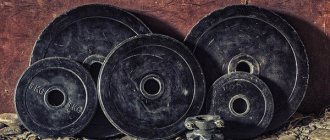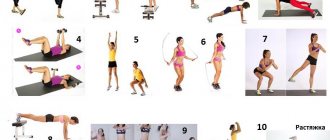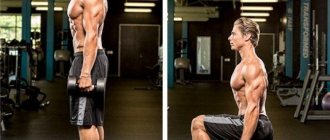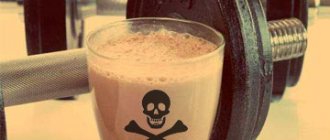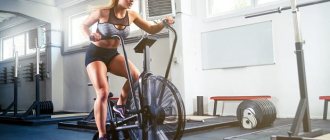Successful training at home or in the gym always means discipline and strict adherence to a well-designed plan. It is impossible to exercise unsystematically, choosing exercises at random. This approach not only does not give any positive results, but often leads to unpleasant consequences in the form of various injuries to muscles, joints and ligaments.
A weekly training program is the minimum plan that allows you to qualitatively include fitness or hard disciplines in your life. Only by following the rules can you lose weight well and form a beautiful muscle profile. There are a few simple tips that will help you create a great program.
Determining the goal of training
The very first step is setting a goal. Getting an answer to the question: “Why do you need to go to the gym or exercise at home?” We bring to your attention several main reasons why a person includes sports in his life:
- Losing weight (fat burning).
- Drying (working out muscle relief).
- Gaining muscle mass.
- Increasing strength and endurance (as well as separately).
The most common choice, of course, is to fight extra pounds and increase muscle mass. In both cases, you need not only a good training program, but also a balanced, healthy diet. To gain muscle, it should be high-calorie, and for fat burning - with a reduced daily calorie content.
Personalization
Each person is unique and each has their own strengths, and this applies not only to character, thinking, but also to genetic potential. Some people's legs begin to grow quickly, some have wide shoulders, some are thin, some have a body, some are lean. Everyone has their own genetic potential. You've probably seen people like this in the gym; one muscle group stands out well, while the other is barely visible. If you don’t adjust your training program to suit yourself, you will have the same situation. Develop your weaknesses. Let's say you have narrow shoulders, focus on them, your training in the gym should start with this muscle group. If your chest is growing quickly, well and good, start training it once every two weeks, inserting your lagging muscle group. It is worth developing the whole body harmoniously, and not what “comes easily”.
Use this program and tips for “upgrading” and your workout in the gym will be extremely productive, and your body will very quickly transform and get as close as possible to the body you dream of. I also want to repeat that nutrition plays a huge role in bodybuilding, it is as important as training, because at a construction site you cannot build a house without bricks, and here too. As a result, if you don’t have the material to build new muscles, why did you “hire workers” (go and train). Therefore, I strongly recommend reading the articles on nutrition for weight gain on this site, where you will find everything you need to know. With this, I say goodbye to you and wish you good mass gain.
Oh yeah, a couple of workout tips for those who want to lose weight.
- Don't stop doing basic exercises, they help produce testosterone, which in turn will help you burn excess fat.
- You can do one more exercise than when gaining weight and reduce the weight by 10-20%, but increase the number of repetitions to 15. But you should not do this in basic exercises.
- Add to your regular workout - cardio training for 30 - 40 minutes at the end of the workout will be enough. (running, brisk walking, exercise bike, etc.)
Otherwise, the training will be identical, but with nutrition you need to change everything radically, training in the gym is a very important aspect of building the body, but without good nutrition, training can become useless, and sometimes even harm the body. That's why we've written and made available to the public on our website many useful articles on nutrition that will give you the right amount of information for proper nutrition while taking into account intense training. Train smart and always learn new things!
Selecting exercises: sorting by directions
There are a lot of exercises. And if you include various sports equipment in your work, there will be even more of them. When drawing up a program for the week, it is important to clearly determine what format of exercises you need. They are all divided into several categories:
- Aerobic. Otherwise called cardio. Energy is provided through a chemical reaction with glycogen in the presence of oxygen.
- Anaerobic. These are strength exercises. Muscles contract due to the use of creatine phosphate and glycogen, but without the participation of oxygen. As a result, lactic acid is formed.
- Complex. A combination of aerobic and anaerobic exercise.
Interesting fact. In gyms, the emphasis is on strength (anaerobic) training. Exercises are performed using various weights, weights and other equipment. They help build muscle, but are not suitable for weight loss.
If you are planning to lose a couple of extra pounds, then the basis of the program should be aerobic exercise. In a fitness center, the following are suitable for performing them: jump ropes, steppers, exercise bikes, and a treadmill.
Below is a list of tips for this training program:
- Again, learn the correct technique for doing the exercises. Especially the basic ones.
- To begin with, use light weights (especially in compound exercises) to hone your technique. If you get injured, you can simply forget about training. It will haunt you every workout, even if you have healed it and even after several years.
- Start your training day with a warm-up approach and a warm-up in general. Before your workout in the gym begins, start doing a warm-up on all ligaments and tendons, do a little stretching (yes, just like in physical education), then you should run for 5 minutes on a treadmill in order to disperse the blood throughout the body. This way you will warm up the working muscles and you can start. For the first set of the first exercise, start with a warm-up weight, let it be 50-60% of your working weight. This is also necessary to avoid injury and by doing this you will set up your brain to correctly perform the following approaches.
- Increase your working weight. The warm-up is done, the first warm-up approach is done, now it’s time to do the working approach. Let it not be the maximum weight, but 90% of your maximum weight (at which you can do at least 8-10 repetitions). Once done, the next set add 10% more weight. This is your working weight. On the third (working) set, add another 5-10% and try to do at least 8 repetitions. This way, you will progress steadily with the weights, and you will also become very flexible in terms of working with different weights. You will be able to instantly select weights in such a way as to do the maximum number of repetitions as possible for you. This will give you maximum performance in each exercise.
- The number of repetitions in the exercise. Why exactly 8-10 repetitions you ask? I will say this, these are conditional figures. Each muscle group doesn't care how many repetitions you do. It is important to her how long they spent under load and whether the load was sufficient. And the number of repetitions serves as a guide for you, so that it is easier for you to understand how long to repeat in an exercise. If you did 12 repetitions, it’s okay, it’s even good, here you can leave the same number of repetitions or in the next approach increase the weight to do 10. If you did 6, that’s also good, you can slightly reduce the weight or leave it at the same level. But if you do 15 or more repetitions in a basic exercise, this weight is too small for you, it’s worth adding weight. Because you put the proper load on the body. However, this only applies to basic exercises; for isolated exercises with light weights this is an absolutely normal figure. They are necessary for “hammering” the muscle, so to speak. In such exercises, the norm is 15-20 repetitions.
Now I will give 6 “upgrades” of this program so that you can customize it for yourself.
- If you have already adapted to the load and are doing this program or a similar one, add 1-2 isolated exercises for each muscle group. This will “clog” your muscles as much as possible. Efficiency will increase significantly.
- Increase the number of sets of one or two exercises. It is advisable to do this for the first or second exercise. This is done to maximize performance on the “best” exercise. The “best exercise” means the one in which you feel the muscle the most and gives the maximum load.
- Replace "non-working" exercises. If you have difficulty doing some exercise, your technique “suffers” in it, or you don’t feel the load well in it, feel free to change it to another one. Sometimes it happens that one person feels every movement in an exercise, while another does not feel it at all. It depends on many factors. The recommendation here is simple, just change it to a similar exercise. For example: after a bench press, you don’t feel like your chest is engorged (you don’t feel tired in your chest after the approach, there’s no burning) - change this exercise to a dumbbell press. They will allow you to take a different look at a seemingly similar exercise. But you shouldn’t change the basic exercise to an isolated one (let’s say a bench press to a dumbbell fly). We change basic to basic, isolated to isolated.
- Load up in your warm-up. Some athletes (including Arnold) use this method. Before starting the exercises, but after warming up, they do 3-5 sets with light weights to pump blood into the muscles so that they are already tired and then only “bomb” with the main exercises. For example: Before doing back exercises, Arnold did 100 wide-grip pull-ups and only then started doing the rest of the exercises. Naturally, he divided these pull-ups into 3-5 approaches. For beginners, of course, you need to do much less than 30-50 pull-ups, I think that will be enough. This can be done for each muscle group.
Warm-up for all muscle groups before training in the gym
Back – pull-ups (3 sets max)
Legs – extension (3 x 30 repetitions)
Chest - push-pull in the simulator (3 x 20 repetitions)
Shoulders – swings to the sides (3 x 20 repetitions)
Biceps – lifting the barbell in front of you (3 x 20 repetitions)
Triceps – French press (3 x 20 repetitions)
By the way, it is not always worth tiring the biceps and triceps, since they are very small muscle groups and are easy to “hammer” without it. Also remember that you should not take the largest weights, but somewhere around 50-60% of the working ones.
Order of exercises
It is very important to maintain consistency when performing exercises. Chaos in the program is of no use - it will never lead to progress, but will only contribute to internal disturbances, which are not always easy to eliminate.
If a training program compiled by a professional involves doing a heavy exercise first, that’s where you should start. Otherwise, the athlete simply will not have any strength left by the end of the lesson. It is important to strictly follow the recommendations. They make training much more effective.
- Experienced athletes with high physical activity are recommended to divide their training days in a split format. This means that a separate muscle group is assigned to a certain day. For example, on Monday we work with the back, and on Wednesday with the legs, etc.
- For beginners, fullbadi programs are recommended, aimed at working out the whole body. The difference with split training is only in the intensity of the process, as well as the alternation of easy/difficult days.
Training programs for the gym
So, you have mastered the basic set of exercises and want to start more complex ones, aimed at specific muscle groups. Take a look at some programs.
Stronger sex
An approximate set of exercises for men who want to reduce the amount of subcutaneous fat, pump up muscles, increase their volume and increase their endurance. Designed for a height of about 180 cm and a weight of approximately 95 kg. This complex is based on supersets - performing two types of exercises on different muscle groups without rest. Then - rest for 2-3 minutes, and again - superset.
First workout (chest and back)
- Crunches on an incline bench.
- Lifting legs in support.
- Deadlift with a barbell.
- Bent-overs with a barbell on your shoulders.
- Classic bench press.
- Lying dumbbell flyes.
- Bent-over barbell row with a reverse grip.
- Head pull from the upper block.
- Working out on a cardio machine.
Second workout (arms)
- Triceps dips.
- Extension of arms from the upper block.
- Reverse grip chest pull-ups.
- Standing barbell curl.
- “French” bench press with dumbbells while standing.
- Arm curls with dumbbells.
- Seated wrist curl.
- Pullover with dumbbells lying down.
- Working out on a cardio machine.
Third workout (legs and shoulders)
- Crunches from the top block.
- Hyperextension.
- Squats with a barbell on your shoulders.
- Leg extension in the simulator.
- Bench press while standing from the chest.
- Swing dumbbells to the sides.
- Bench press while standing.
- Swing the dumbbells forward alternately.
- Working out on a cardio machine.
Each exercise should be done in 3-5 sets of 10-20 times. Spend at least 10 minutes on the cardio machine. The three types of workouts should be performed in a circuit.
Ways and methods of performing strength exercises
For beginner athletes, it is best to stick to a traditional strength-building and muscle-building regimen. In this case, regular sets are suitable - the rest between elements and the actual approaches is from 2 to 6 minutes. For experienced athletes, more complex methods of performing exercises open up:
- Drop sets. During the training process, the athlete gradually reduces the working weights in the exercise. Reducing each time by about 25%. This way we slowly reach failure. Rest between sets is minimal.
- Supersets. They involve working out certain muscle groups (identical or opposite) by sequentially performing various exercises (two or more). There is no rest between approaches.
- Trisets. One of the varieties of a superset, which involves pumping muscles not with two, but with three exercises performed in succession. There is also no rest.
Interesting fact. Using various methods makes it possible to always keep muscles in good shape, avoiding unpleasant stagnation and the plateau effect.
Principles of mass training
The more a person trains, the more adapted they become to the load, so it is important to select the right amount of load , sufficient to ensure consistent muscle adaptation and further growth. Therefore, it is necessary to constantly increase the working weight so that the muscles adapted to a certain load continue to progress, and therefore increase in volume.
Load
For muscle growth, the optimal number of repetitions is the zone from 8-12 times. Since three approaches with moderate weight are suitable for adaptation to the load, a more prepared athlete needs to perform 4 approaches with maximum weight, working until the muscles “failure”.
So, the weight of the load should be selected in such a way that it cannot be lifted more than 12 times. But not less than eight times , since strength will develop, and working in the minimum repetition range will not increase muscle volume - this is very important.
Rest between approaches should not exceed two minutes; this time is enough to rest the muscles from the load. It is also important to create the correct training schedule for weight, since overwork will not lead to growth. It is advisable to train every other day, and leave two full days of rest. Therefore, a mass training system suitable for most athletes is 3 days a week.
Recovery
Increasing muscle volume will inevitably depend on two things.
- First, in order to progress, muscles need recovery, including adequate rest and consuming the right nutrients;
- and secondly, at some point there will be a “dead point”.
The second usually occurs around the 8-week mark, and is associated with an inability to recover quickly and greater stress on the central nervous system and other important regulators of muscle growth. At this stage, you can reduce the load or rest for several days. This should give the body the opportunity to recover, adapt and grow further.
Nutrition
Athletes need to get enough calories, that is, energy to maintain and grow muscles, from carbohydrates and fats, this is also important for the production of hormones. Proteins should come from quality sources such as meat, eggs, dairy, whey protein, and for those who need additional protein intake and recovery, complete cycle amino acids and BCAA (essential amino acids) are necessary for muscle building.
Remember that the total amount of protein and calories in the diet will be the most important determinant of muscle growth, with supplements to help improve nutrition and "fill in the gaps." Sports supplements like creatine can help maintain strength in the gym, so it's a great option for people looking to maximize muscle growth.
A significant increase in exercise volume can also have a big impact on the immune system, so supplementing with vitamin C is important . Other supplements that will benefit those looking to build muscle are Omega-3, fish oils and Vitamin D.
An important condition for muscle growth is eating immediately after training . Within forty minutes after exercise, the body must replenish its reserves of energy, proteins and carbohydrates. During this period, all nutrients are fully absorbed by the muscles, and this provides a significant impetus for the restoration of damaged tissues, and therefore growth. also important to replenish glycogen reserves after sleep , since catabolic processes begin in a hungry body; timely intake of protein and carbohydrates will stop the breakdown of its own protein.
Curling arms in the Scott machine
Technique:
- We choose the optimal weight, which will increase with each approach. It is recommended to start with 5-10 kg, the second approach – 15 kg, the third – 30 kg, the last – 40 kg.
- Take a position on the machine: your hands are placed on the surface of the bench so that your elbows are approximately shoulder-width apart.
- Perform the exercise at a medium pace (1.5 to 2 seconds).
We do four approaches (three warm-up and one working - we perform the exercise to failure) for 12-15 repetitions. The break between approaches is a minute.
Photo: istockphoto.com
Pull from above
Technique:
- We set a weight that is comfortable for ourselves. With each approach, increase it as much as possible.
- Take the position as follows: your back is straight, your head is directed slightly above the machine.
- We focus on the elbows: they should drop to such a level that the shoulder blades are brought together.
- Exhale as you make an effort, and inhale as you return to the starting position.
We do four approaches (three warm-up and one working - we perform the exercise to failure) for 12-15 repetitions. The break between approaches is a minute.
